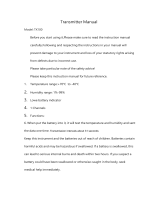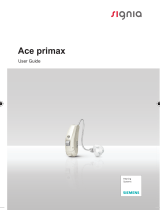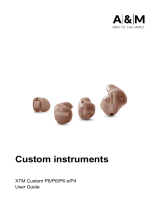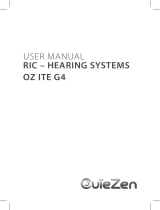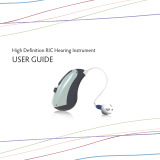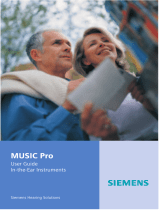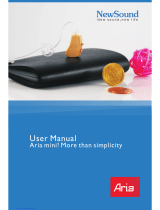Page is loading ...

USER GUIDE
RECEIVER-IN-EAR HEARING INSTRUMENT

2 3
Hearing instrument type designations for models included in this user guide are: SY312, FCC ID: X26SY312,
IC: 6941C-SY312; SY312e, FCC ID: X26SY312e, IC: 6941C-SY312e; and MRIE, FCC ID: X26MRIE, IC:
6941C-MRIE. FCC ID: X26VE312; VE312, IC: 6941C-VE312. Please see page 6 for list of models referring
to all types.
Statement:
This device complies with part 15 of the FCC rules and ICES-003 of the IC rules.
Operation is subject to the following two conditions: (1) this device may not cause harmful inter ference,
and (2) this device must accept any interference received, including interference that may cause undesired
operation.
Note: This equipment has been tested and found to comply with the limits for a Class B digital device,
pursuant to part 15 of the FCC Rules and ICES-003 of the IC rules. These limits are designed to provide
reasonable protection against harmful interference in a residential installation. This equipment generates,
uses and can radiate radio frequency energy and, if not installed and used in accordance with the instruc-
tions, may cause harmful interference to radio communications.
However, there is no guarantee that interference will not occur in a particular installation. If this equipment
does cause harmful interference to radio or television reception, which can be determined by turning the
equipment off and on, the user is encouraged to try to correct the interference by one or more of the fol-
lowing measures:
• Reorient or relocate the receiving antenna.
• Increase the separation between the equipment and receiver.
• Connect the equipment into an outlet on a circuit different from the one in which the receiver is con-
nected.
• Consult the dealer or an experienced radio/TV technician for help.
Changes or modifications can void the user´s authority to operate the equipment.
Intended use
Generic air-conduction hearing instruments are wearable sound-amplifying devices intended to compen-
sate for impaired hearing. The fundamental operating principle of hearing instruments is to receive, amplify,
and transfer sound to the ear drum of a hearing impaired person.
List of countries:
Products without wireless functionality are intended for worldwide sales.
In the EU, products with wireless functionality are intended for sale in countries within European Economic
Area as well as Switzerland.

4 5
ReSound is a registred trade mark of ReSound A/S
Introduction
Congratulations on the purchase of your new hearing instruments. ReSound’s innovative sound technology
and design, combined with the customised device programming selected by your hearing care profes-
sional, will make hearing a more enjoyable experience. Hearing instruments will enable you to hear sounds
that you may not have heard in years because of your hearing loss. Practice and a positive attitude are
important in learning to use hearing instruments. Your ReSound instruments have been adjusted according
to your individual hearing loss and needs. Some people adjust quickly to wearing hearing instruments in
their ears and hearing new sounds; other people may need more time.
Please read this manual carefully in order to wholly benefit from the use of your hearing instruments. With
proper care, maintenance, and usage, your hearing instruments will aid you in better communication for
many years. Ask your hearing care professional if you have any questions.
The products are in compliance with the following regulatory requirements:
• In EU: the device conforms to the Essential Requirements according to Annex I of Council Directive
93/42/EEC for medical devices (MDD) and essential requirements and other relevant provisions of Direc-
tive 1999/5/EC (R&TTE).
• The declaration of conformity may be consulted at www.resound.com
• In US: FCC CFR 47 Part 15, subpart C.
• Other identified applicable international regulatory requirements in countries outside EU and US. Please
refer to local country requirements for these areas.
• In Canada: these hearing instruments are certified under the rules of IC.
• Cet appareil numérique de la classe B est conforme à la norme NMB-003 du Canada.
• Japanese Radio Law and Japanese Telecommunications Business Law Compliance. This device is
granted pursuant to the Japanese Radio Law (電波法) and the Japanese telecommunications Business
Law (電気通信事業法) This device should not be modified (otherwise the granted designation number
will become invalid)
• Patents
US 7,593,537 US 8,00,849

6
Micro receiver-in-the-ear (RIE) hearing in-
struments with size 10A battery are available in
the following variants:
AL960-DR, AL760-DR, AL560-DR ALT960-DR
VO960-DR, VO760-DR, VO560-DR, VOT960-DR,
VOT760-DR
Mini receiver-in-the-ear (RIE) hearing instru-
ments of type SY312 with FCC ID X26SY312, IC
number 6941C-SY312 and
size 312 battery are available in the
following variants:
AL961-DRW, AL761-DRW AL561-DRW, AL461-
DRW ALT961-DRW
Mini receiver-in-the-ear (RIE) hearing instru-
ments of type SY312e with FCC ID X26SY312e,
IC number 6941C-SY312e and size 312 battery
are available in the following variants:
VO961-DRW, VO761-DRW, VO561-DRW, VOT961-
DRW, VOT761-DRW
Mini Receiver In-the-Ear (RIE) hearing
instruments of type VE312 with FCC ID:
X26VE312, IC number 6941C-VE312 and size
312 battery are available in the following
variants:
LN961-DRW, LN761-DRW, LN561-DRW, LNT961-
DRW, LNT761-DRW
Receiver-in-the-ear (RIE) hearing instruments
of type MRIE with FCC ID X26MRIE, IC number
6941C-MRIE and size 312 battery are available
in the following variants:
AL962-DVIRW, AL762-DVIRW AL562-DVIRW,
AL462-DVIRW ALT962-DVIRW, ALT762-DVIRW
VO962-DRW, VO762-DRW, VO562-DRW,
VOT962-DRW, VOT762-DRW
The identification number for the MRIE, SY312,
SY312e, and VE312 device models can be found at
location “15” as indicated in the illustrations on page 9.
Hearing instrument model:
Model 60: Battery size 10
Model 61: Battery size 312
Model 62: Battery size 312
Receiver tube length:
Dome size:
Left serial number:
Right serial number:

Contens
Introduction...............................5
Getting started ...........................12
On/Off function ...........................12
SmartStart ..............................12
Inserting/Replacing the battery...............12
Low battery indicator ......................13
Sports lock ..............................14
Inserting/Removing hearing instruments........14
Program and Multi-Function buttons ..........16
Flight mode* (Wireless models only) . . . . . . . . . . . 19
Telephone use............................21
Listen to radio or TV .......................22
Using ReSound Hearing Instruments with iPhone
®
,
iPad
®
, and iPod touch
®
(ReSound LiNX) ........22
Cellular phones...........................22
PhoneNow ..............................23
Telecoil (optional)..........................25
Tele-loop systems.........................26
Direct audio input (optional) .................26
Connecting/Disconnecting audio boots ........26
Care and maintenance .....................27
Daily maintenance.........................28
The receiver tube .........................29
Cleaning the receiver tubes and domes ........29
Cleaning RIE or moulds ....................29
Changing wax guard for receiver tube .........30
How to apply domes.......................31
Using ReSound hearing instruments with smart
phone apps..............................33
General precautions .......................34
General warnings .........................35
Tinnitus Sound Generator (TSG) module .......36
TSG warnings ............................37
User instructions for the TSG module ..........37
TSG precautions..........................39
The scientific concepts that form
the basis for the device .....................40
Significant physical characteristics ............40
Prescription use of this TSG hearing instrument ..41
Important notice for prospective sound generator
users...................................41
TSG warning to hearing healthcare professionals 42
Battery warning information .................43
Hearing instrument expectations .............43
Warning to hearing aid dispensers (US Only) ....44
Important notice for prospective
hearing aid users (US Only)..................44
Children with hearing loss (US Only) ..........45
Troubleshooting Guide .....................46
Technical data............................50
Warranty and repairs ......................64
Temperature test, transport and
storage information ........................64

7
1
8
2
7
7
9
9
1
1
8
8
2
2
3
15
14
6
9, 10
1
8
2
15
16
14
7
5
13 17
4
11 12
10 11
60 models
61 models
(type SY312e and
SY312)
1. Receiver tube
2. Receiver Open Dome
3. Receiver Tulip Dome
4. Receiver Power Dome
5. RIE mould
6. Sports lock
7. Battery compartment
8. Receiver
9. Push button
10. Volume Control (optional)
11. S receiver tube
12. NP receiver tube
13. HP receiver tube
14. Left/right indicator
15. Model, and serial number
16. Direct audio input
17. UP Receiver/Mould
62 models
(type MRIE)
(Indentification number for the SY312e
and SY312 devices)
ReSound LiNX
TM
device

2
1
3
12 13
i
Tip:
1. Always use new Zinc-Air batteries that have a minimum remaining shelf life of one year.
2. Whenever the hearing instruments are not in use, remember to turn them off to avoid unnecessary
battery consumption.
Low battery indicator
Your hearing care professional can set your hearing instrument to give an acoustical indication when the bat-
tery is reaching its end of life. The hearing instrument will reduce amplification and emit a melody if battery
power gets too low. This signal will recur every five minutes (every 15 minutes for the LiNX models) until the
hearing instrument automatically switches off. It is recommended that you keep spare batteries on hand.
Low battery indicator (instruments paired with accessories only)
Active usage of the ReSound Unite accessories (Remote Control, Phone Clip, TV Streamer and Mini Micro-
phone) requires more battery power from the hearing instruments than when these are working on their own
meaning that battery life is highly dependent on the amount of wireless accessory usage. When the battery
in the hearing instrument has depleted to a level at which use of the ReSound Unite TV Streamer, Phone
Clip and Mini Microphone cannot be supported, the hearing instrument will play two sets of descending
tones. After this, your hearing instrument and ReSound Unite Remote Control will continue to work as usual,
but you will not be able to use your ReSound Unite TV Streamer, Phone Clip and Mini Microphone. At some
point the battery level will not support the remote control either and you will once again hear the descending
tones. The hearing instruments will continue to work as usual. Once a new battery is inserted, full operation
of the accessories will resume.
Getting started
On/Off function
1. When the battery door is closed, the hearing instrument turns on,
and the default program will be activ ated.
2. To turn off the hearing instrument, open the battery door. Use your
fingernail to pull it open.
SmartStart
Hearing instruments can be turned on once you have placed them on your ears. If you prefer to turn them on
just prior to placing them on your ear, your hearing care professional can activate a function called Smart-
Start. This function will delay the time in which the hearing instruments turn on after the battery compart-
ment is closed. With SmartStart, a beep will be heard for each second of the delay period.
Inserting/Replacing the battery
1. Open the battery door completely by using your fingernail. Remove the used battery if present.
2. Prepare the new battery (please refer to page 7 for information on appropriate battery type/size for your
hearing instrument). Remove the protective foil and wait 2 minutes before inserting the battery into the
hearing instrument to allow activation of the battery.
3. Insert the new battery with the positive side in the correct position.
4. Gently close the battery door.
On
Off

14 15
Insertion (domes)
1. Hold the receiver tube where it bends, and
gently place the dome into the ear canal.
Push the dome far enough into the ear canal
so that the receiver tube lies flush with the
side of the head.
2. It is important that the tube and the dome fit
correctly into your ear.
3. When the dome is placed correctly, you should not be able to see the receiver tube sticking out when
facing a mirror.
i Note: You should never attempt to bend or modify the shape of the receiver tube.
Removal (RIE moulds)
1. Grasp the removal string and pull the RIE or UP mould outward.
2. Consult your hearing care professional if you have difficulties removing the hearing instrument.
Removal (domes)
1. Hold the receiver tube with your thumb and forefinger and remove the tube.
2. Consult your hearing care professional if you have difficulties removing the
hearing instrument.
Sports lock
The sports lock will be applied or adjusted by your hearing care professional.
Inserting/Removing hearing instruments
Insertion (custom RIE and UP moulds)
1. Hold the RIE mould between your thumb and index finger and position its sound
outlet in your ear canal.
2. Slide the RIE mould all the way into your ear with a gentle, twisting movement.
3. Move the RIE mould up and down and gently press to ensure it is positioned correctly
in the ear. Opening and closing your mouth can ease insertion.
4. Make sure the hearing instrument is seated behind the ear.
By experimenting, an easier method may be discovered. With proper insertion, hearing
instruments should fit snugly but comfortably. If hearing instruments cause irritation of
the ears, contact your hearing care professional.
i Never attempt to modify the shape of the hearing instrument, RIE moulds, or tubing yourself.
i
Tip: It may be helpful to pull the top of your ear back with your opposite hand during insertion to open
the ear canal.

16 17
Program and Multi-Function buttons
If you have a hearing aid with a program button or multi-function button, this will allow you to use up to four
different listening programs, each of them suitable for certain situations.
Program button (61 models only) Multi-function button (62 models only)
Your hearing care professional can fill out the following table for you.
Programme Description of when to use
1
2
3
4
When using the program or multi-function buttons to switch programs, each press will move the instrument
to the next program. For example, if it was in program 1 it will switch to program 2, if it was in program 2 it
will switch to program 3 etc.
When you close the battery door and switch the instrument on, it will start in program 1. Press the program
or multi-function buttons if you want to move to a different listening program.
If you have two hearing instruments with the synchronization function enabled, program changes to one
instrument will automatically repeat in the second instrument. When a program change is made in one
instrument, you will hear the same amount of confirmation beeps in the second instrument.
Your instrument has a fully automatic volume control. Therefore, it should not be necessary to control the
volume manually.
However, in addition to controlling listening programs, the multi-function button (62 models only) provides
you with the ability to adjust the amplification to your liking.

18 19
i Flight mode* (Wireless models only)
When boarding a flight or entering an area where RF transmitters are prohibited, wireless functionality must
be deactivated, as it is not allowed to radiate radio signals during flights or in otherwise restricted areas.
For Alera wireless hearing instruments follow the following steps to enter and leave flight mode:
It is possible to disable wireless operation by opening and closing the battery compartment of the hearing
instrument while at the same time pressing the push button.
When disabled manually, wireless operation may be re-enabled by opening and closing the battery com-
partment normally, (i.e. without at the same time pressing the push button).
For all other wireless hearing instruments follow the following steps to enter and leave flight
mode: It is possible to disable wireless operation by opening and closing the battery compartment three
times within a ten second period (open-close, open-close, open-close). Your instruments will now be in
flight mode.
If you have two hearing instruments with the synchronization function enabled and you have the Multifunc-
tion Button set for volume control functionality, volume adjustments to one instrument will automatically
repeat in the second instrument. When a volume control adjustment is made in one instrument, you will hear
a confirmation beep. A beep in the second instrument will follow.
The multi-function button is designed to change the volume or listening programs of the hearing instrument,
based on different ways it is pressed.
If necessary, your hearing care practitioner can change these settings and fill in the following table to indi-
cate the new settings:
Multi-function button action Default setting New setting
Short press up Increases volume
Short press down Decreases volume
Long press up (3 seconds) Changes programs
Long press down (3 seconds Activates streaming
*For wireless models only

20 21
Telephone use
If your hearing instruments are fit with a receiver open dome or receiver tulip dome, you can probably use
the telephone as you normally would by holding it up to your ear canal opening. If your hearing instruments
are fit with a receiver power dome or RIE or UP mould, finding the optimal position for holding a telephone
while using a hearing instrument may require practice for some individuals, and one or more of the following
suggestions may be helpful.
1. Hold the telephone as you would normally.
2. Hold the telephone towards the top of the ear (closer to where the microphones are located).
3. If whistling occurs, it may take a brief moment of holding the telephone in the same position before the
hearing instrument adapts and reduces the feedback.
4. Any whistling may also be decreased by holding the telephone slightly away from the ear.
5. Depending on your individual needs, your hearing care professional may activate a programme
specifically for telephone use.
If the hearing instrument is in flight mode, the hearing instrument must have been operating in flight mode
for at least 10 seconds before attempting to enable wireless again. it is possible to re-enable wireless opera-
tion by opening and closing the battery door once. 10 seconds after this operation is completed, wireless
operation will begin again.
i
Note: It is important to wait an additional 15 seconds after wireless function resumes before open-
ing and closing the battery compartment again for any reason. If the battery compartment is opened and
closed during this 15 second window, flight mode will resume.
*For wireless models only

22 23
Listen to radio or TV
When listening to the TV or the radio, start out by listening to news commentators since they usually speak
clearly, then try other programmes.
If you find it difficult to listen to TV or radio, your hearing care professional will be able to give you advice on
available accessories to enhance your listening capabilities for TV and radio.
Using ReSound Hearing Instruments with iPhone
®
, iPad
®
,
and iPod touch
®
(ReSound LiNX)
ReSound LiNX is a Made for iPhone instrument and allows for direct communica-
tion and control with an iPhone, iPad, or iPod touch. Note that MFi functionality
is not supported in the LiNX 5 product. For assistance in pairing and using these
products with your ReSound LiNX device, please contact your hearing care pro-
fessional or visit our support site at www.resound.com/linx.
Cellular phones
Your hearing instrument is designed to comply with the most stringent Standards of International Electro-
magnetic Compatibility. However, not all cell phones are hearing instrument compatible. The varying de-
gree of disturbance can be due to the nature of your particular cellular phone or of your wireless telephony
service provider.
If you find it difficult to obtain a good result while using your cellular phone, your hearing care professional
will be able to give you advice on available accessories to enhance listening capabilities.
PhoneNow
The PhoneNow function, allows your hearing instrument to automatically
switch to your tele phone programme when a telephone receiver is raised
to the ear. When the telephone receiver is removed from the ear, the hear-
ing instrument automatically returns to the previous listening programme.
Placement of PhoneNow magnets
Place PhoneNow magnet on your telephone receiver to allow operation
of the PhoneNow function. In order to place PhoneNow magnet properly:
1. Clean the telephone receiver thoroughly.
2. Hold the telephone vertically, in a position similar to when making a telephone call.
3. Place the magnets just below the telephone receiver. Make sure not to cover the microphone openings.
If necessary, move the magnet to another position to improve ease of use and comfort while speaking.
4. If you are not satisfied with the strength of PhoneNow, you can reposition the PhoneNow magnet or add
additional PhoneNow magnets.

24 25
PhoneNow usage
Telephones can be used in a normal manner. A short melody will indicate that the PhoneNow feature has
automatically switched the hearing instrument to your telephone programme. Initially, you may need to
move the telephone receiver slightly to find the best position for reliable PhoneNow activation and good
hearing on the telephone.
If you have two hearing instruments with the synchronization function enabled, the volume of hearing instru-
ment on the non-phone ear will be turned down.
i
Only use recommended cleaning agent to clean the telephone prior to placing the magnet on the
phone in order to obtain best possible adherence.
i PhoneNow precautions
1. Keep magnets out of reach of pets, children and mentally challenged persons. If a magnet is swallowed,
please seek advice from a medical practitioner.
2. The magnet may affect some medical devices or electronic systems. The manufacturer of any
magnetically sensitive devices (e.g. pacemakers) should advise you regarding appropriate safety
precautions when using your hearing instrument and magnet in close proximity to the medical device
or electronic system in question.If the manufacturer cannot issue a statement, we recommend keeping
the magnet or a telephone equipped with the magnet 30 cm (12”) away from magnetically sensitive
devices (e.g. pacemakers).
3. High distortion during dialing or phoning may mean that the magnet is not in the optimal position relative
to the telephone receiver. To avoid the issue, please move the magnet to another place on the telephone
receiver.
4. Only use magnets supplied by ReSound.
Telecoil (optional)
If equipped, a telecoil can be activated by your hearing care professional and accessed through one of
the additional programmes. A telecoil picks up a telephone’s magnetic signal and converts it to sound. An
optional telephone programme may help to improve speech understanding on the telephone. When using
a telecoil programme, the receiver of the telephone may need to be held closer to the hearing instrument.
The handset of the telephone may need to be moved to slightly different positions in order to find the best
reception.

1
3
2
4
5
26 27
Tele-loop systems
Many places, such as theatres, houses of worship, and schools are equipped with tele-loop systems. When
using a telecoil programme with tele-loop systems, sound is picked up directly and may improve speech
understanding. If there is no sound from the hearing instruments in a tele-loop system and with a telecoil
programme activated, the tele-loop system may not be turned on or is not operating correctly. If a facility is
not equipped with a tele-loop system, sitting as close as possible to the front may be helpful.
Direct audio input (optional)
Use of direct audio input (DAI), which enables a direct connection of the hearing instruments to items such
as television, radio, and remote microphones, may increase speech understanding for some individuals.
The sound source is connected to the hearing instruments by a cable or a wireless FM system to the audio
boot. This accessory connects to the bottom of the hearing instruments, and once properly clicked into
place, the hearing instruments switch to DAI automatically.
Connecting/Disconnecting audio boots
Connecting audio boots
1. Align the tip of the audio boot with the groove just above the battery compartment and below the model
number.
2. Once in place, move the boot in the direction of the battery compartment.
3. Gently click the audio boot onto the hearing
instrument.
Disconnecting audio boots
4. Press and hold the button on the front side of the
audio boot.
5. Gently remove the audio boot from the hearing
instrument.
i
Care and maintenance
Please follow the following instructions to prolong the
durability of your hearing instruments:
1. Keep your hearing instrument clean and dry. Wipe
the case with a soft cloth or tissue after use to
remove grease or moisture. Do not use water or
solvents, as these can damage the hearing instrument(s).
2. Never immerse hearing instruments in water or other liquids, as liquids may cause permanent damage
to the hearing instruments.
3. Avoid rough handling of hearing instruments or dropping them on hard surfaces or floors.
4. Do not leave hearing instruments in or near direct heat or sunlight, such as in a hot, parked car, as
excessive heat can cause damage or deform the casing.
5. Do not wear your instrument while showering, swimming, in heavy rain or in a moist atmosphere such
as a steam bath or sauna.

28 29
The receiver tube
The receiver tube contains the wiring to the receiver which delivers the sound to the ear canal. It is important
that the receiver tube and the receiver dome/RIE mold fits correctly in your ear. If the receiver tube or the
receiver dome/RIE mould irritates your ear in any way and prevents you from wearing your hear ing instru-
ment, please contact your hearing care pro fessional. You should never attempt to modify the shape of the
receiver tube yourself. The receiver tube and the receiver dome/RIE mould should be cleaned regularly.
Please see instructions in the next section.
i
Cleaning the receiver tubes and domes
The receiver tube and the receiver dome should be cleaned regularly. Use a damp cloth to clean the re-
ceiver tube and receiver dome on the outside. Do not use water when you are cleaning the receiver tubes
or the receiver domes. This process is also used to clean the UP receiver mould. Please see instruction on
page 30 or 31 for how to change the wax guard filter.
i
Cleaning RIE or moulds
1. Separate the mould from the receiver tube.
2. Clean the RIE mould using a mild soap, and rinse with lukewarm
water.
3. After cleaning, dry RIE moulds thoroughly and remove any residual
water and debris from the tubing utilising an air bulb and wire loop.
6. If your instrument does get wet, or if it has been exposed to high humidity or perspiration, it should be
left to dry out overnight with the battery out and the battery compartment open. It is also a good idea to
put the instrument and battery in a sealed container together with a drying agent (desiccator) overnight.
Do not use the instrument until it is completely dry. Consult your hearing care professional as to which
drying agent to use.
7. Remove your hearing instrument when applying such things as cosmetics, perfume, aftershave, hair
spray, and suntan lotion. These might get into the instrument and cause damage.
i
Daily maintenance
It is important to keep your hearing instrument clean and dry. On a daily basis, clean the hearing instru-
ments using a soft cloth or tissue.

1
2
3 4
5
10
9
8
7
6
1
2
30 31
Changing wax guard for receiver tube
For NP receivers:
1. Clean any debris from the old waxguard.
2. Insert the wand into the old waxguard.
3. Twist the wand with the waxguard in a clockwise direction to ensure it is attached to the wand.
4. Pull the wand and waxguard away from the tube/mould.
5. Insert the old waxguard into the center of the HF3 wheel.
6. Dispose of the old waxguard by drawing the wand to the narrow end of the center disposal area.
7. Insert the empty wand into a new waxguard on the HF3 wheel.
8. Pull the new waxguard attached to the wand away from the HF3 wheel.
9. Insert the wand into the receiver tube/mould.
10. Twist the wand to release the new waxguard onto the receiver tube/mould.
For S and HP
2
receivers:
1. To remove the old wax guard, insert the removal side of the wax guard tool into the used wax guard
so that the shaft of the tool is touching the rim of the wax guard. Slowly pull the wax guard straight
out.
2. To insert the ne w wax guard, gently press the replacement side of the wax guard tool straight into
the hole of the sound outlet until the outer ring lies flush with the outside of the receiver. Pull the tool
straight out -the new wax guard will remain in place.
How to apply domes
It is recommended that your hearing care
professional change domes, as incorrect
dome replacement could result in injury.
ReSound standard domes
1. Push the new dome over the receiver.
2. Make sure that the new dome is
properly and securely mounted.

32 33
ReSound tulip domes
Tulip domes are mounted in a similar manner to standard domes, but a few extra steps are required. Tulip
domes consist of two “petals”. It is important to note that the largest petal is the outermost petal. To ensure
this:
1. Push the largest petal away from
the receiver tube using a finger. This
bends the petal forward.
2. Then push the largest “petal” back,
and it will be placed on top of the
smaller petal.
Using ReSound hearing instruments with smart phone apps
i
Intended use of smart phone apps:
GN ReSound smart phone apps are intended to be used with GN ReSound wireless hearing aids. GN Re-
Sound smart phone apps send and receive signals from the GN ReSound wireless hearing aids via smart
phones for which the apps have been developed.
Use with smart phone apps:
• Notifications of app updates should not be disabled, and it is recommended that the user installs all
updates to ensure that the app will function correctly and will be kept up to date.
• The app must only be used with GNR devices for which it is intended, and GNR take no responsibility if
the app is used with other devices.

34 35
i General precautions
1. Special care should be exercised in selecting and fitting a hearing instrument(s) who’s maximum sound
pressure level exceeds 132 dB SPL (with an IEC 60711:1981 occluded ear simulator), because there
may be a risk of impairing the remaining hearing of the hearing instrument user
2. Do not leave hearing instruments in the sun, near an open fire, or in a hot, parked car.
3. Do not wear hearing instruments while showering, swimming, in heavy rain, or in a moist atmosphere
such as a steam bath or sauna.
4. Should the hearing instrument become moist, remove the battery and place the hearing instrument in
a closed container with a drying agent. Your hearing care professional can provide options for drying
containers or kits.
5. Remove the hearing instruments when applying items such as cosmetics, perfume, after-shave, hair
spray, and suntan lotion.
6. When wireless function is activated, the device uses low-powered digitally coded transmissions in
order to communicate with other wireless devices. Although unlikely, nearby electronic devices may be
affected. In that case, move the hearing instrument away from the affected electronic device.
7. When using wireless functionality and the devices are affected by electromagnetic interference, move
away from the source.
8. Use only original GN ReSound consumables e.g. tubes and domes. Never attempt to modify the shape
of the hearing instrument, ear-moulds, or tubing yourself.
9. Do only connect ReSound hearing instruments to ReSound accessories intended and qualified to be
used with ReSound hearing instruments.
i General warnings
1. Consult a hearing care professional if you discover a foreign object in your ear canal, if you experience
skin irritation, or if excessive ear wax accumulates with the use of the hearing instrument.
2. Different types of radiation, from e.g. NMR, MRI, or CT scanners, may damage hearing instruments. It
is recommended not to wear hearing instruments during these or other similar procedures. Other types
of radiation, such as burglar alarms, room surveillance systems, radio equipment, mobile telephones,
contain less energy and will not damage hearing instruments. However, they have the potential to
momentarily affect the sound quality or temporarily create strange sounds from hearing instruments.
3. Do not wear hearing instruments in mines, oil fields, or other explosive areas unless those areas are
certified for hearing instrument use.
4. Do not allow others to use your hearing instruments. This may cause damage to the hearing instruments
or to the hearing of the other individual.
5. Instrument usage by children or mentally challenged persons should be supervised at all times to
ensure their safety.The hearing instrument contains small parts that could be swallowed by children.
Please be mindful not to leave children unsupervised with this hearing instrument.
6. Hearing instruments should be used only as prescribed by your hearing care professional. Incorrect
use may result in hearing loss.

36 37
i
TSG warnings
• Sound generators can be dangerous if improperly used.
• Sound generators should be used only as advised by your doctor, audiologist, or hearing healthcare
professional.
• Sound generators are not toys and should be kept out of reach of anyone who might cause themselves
injury (especially children and pets).
User instructions for the TSG module
Description of the device
The Tinnitus Sound Generator (TSG) Module is a software tool that generates sounds to be used in tinnitus
management programmes to relieve suffering from tinnitus.
Explanation of how the device functions
The TSG module is a frequency and amplitude shaped white-noise generator. Noise signal level and fre-
quency characteristics can be adjusted to the specific therapeutic needs as determined by your doctor,
audiologist or hearing healthcare professional.
Your doctor, audiologist or hearing healthcare professional can modulate the generated noise with the
purpose of making it more pleasant. The noise can then resemble, for example, crushing waves on a shore.
Modulation level and speed can also be configured to your likes and needs.
7. External devices connected to the electrical input must be safe according to the requirements of IEC
60601-1-1, IEC 60065, or IEC 60950-1, as appropriate (wired connection, f.ex. HI-PRO), SpeedLink).
8. If device is broken, do not use.
9. Be careful when boarding flights, to remember to deactivate the wireless functionality. Turn off your
wireless functionality by using the flight mode in areas where radio frequency emission is prohibited.
i
Note:
* ReSound wireless devices operate in the frequency range of 2.4 GHz - 2.48 GHz.
* ReSound wireless devices include a RF transmitter that operates in the range of 2.4 GHz - 2.48 GHz.
* For use of wireless functionality only use ReSound Unite accessories. For further guidance regarding e.g.
pairing, please refer to the user guide of the relevant ReSound Unite accessory.
Tinnitus Sound Generator (TSG) module
Intended use for the TSG module
Your ReSound hearing instruments may also include the Tinnitus Sound Generator function, a tool for gen-
erating sounds to be used in tinnitus management programmes to relieve suffering from tinnitus.

38 39
If your tinnitus troubles you only in quiet environments, your doctor, audiologist or hearing healthcare pro-
fessional can set the TSG Module so that it becomes audible exclusively in such surroundings. The overall
sound level can be adjusted via an optional volume control. Your doctor, audiologist or hearing healthcare
professional will review with you the need for having such a control.
TSG volume control
The sound generator is set to a specific loudness level by the hearing healthcare professional. When switch-
ing the sound generator on, the volume will have this optimal setting. Therefore, it might not be necessary
to control the volume (loudness) manually. However, the volume control provides the ability to adjust the
volume, or amount of stimulus, to the liking of the user.
i
Caution
• The volume control is an optional feature in the TSG module used for adjusting the sound generator
output level. To prevent unintended usage by pediatric or physically or mentally challenged users, the
volume control must, if enabled, be configured to only provide a decrease of the sound generator output
level.
i
TSG precautions
• Should the user develop any side effects from using the sound generator, such as dizziness, nausea,
headaches, perceived decrease in auditory function or increase in tinnitus perception, the user should
discontinue use of the sound generator and seek medical evaluation.
• Children and physically or mentally challenged users will require guardian supervision while wearing the
TSG hearing instrument.
/
